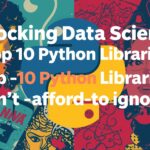- Hands-On Practice – You learn how to clean, preprocess, and analyze messy datasets.
- Problem-Solving Skills – Real-world data rarely looks like textbook examples. Projects make you creative.
- Portfolio Building – Recruiters want proof of skills, not just certifications.
- Confidence Boost – Completing projects helps you crack technical interviews.
- End-to-End Thinking – You learn how to take a project from raw data to final insights.
Levels of Data Science Projects
To make things structured, we’ll break projects into three levels:
- Beginner – Focused on Python basics, data cleaning, and visualization.
- Intermediate – Includes machine learning algorithms and structured datasets.
- Advanced – Involves deep learning, NLP, and big data.
Beginner Data Science Projects with Python
1. Exploratory Data Analysis (EDA) on Titanic Dataset
The Titanic dataset is one of the most popular datasets for beginners. It contains passenger information like age, gender, ticket class, and survival status.
Goal: Analyze survival patterns and predict survival chances.
Skills Used:
- Pandas & NumPy for data handling
- Seaborn & Matplotlib for visualization
- Logistic Regression for prediction
Dataset: Titanic Dataset on Kaggle
Sample Code:
import pandas as pd
import seaborn as sns
import matplotlib.pyplot as plt
# Load dataset
df = pd.read_csv("titanic.csv")
# Check first rows
print(df.head())
# Survival by gender
sns.countplot(x="Survived", hue="Sex", data=df)
plt.show()
# Fill missing age values with median
df['Age'].fillna(df['Age'].median(), inplace=True)
# Logistic Regression
from sklearn.model_selection import train_test_split
from sklearn.linear_model import LogisticRegression
X = df[['Age', 'Pclass', 'SibSp', 'Fare']]
y = df['Survived']
X_train, X_test, y_train, y_test = train_test_split(X, y, test_size=0.2)
model = LogisticRegression(max_iter=200)
model.fit(X_train, y_train)
print("Accuracy:", model.score(X_test, y_test))2. Movie Recommendation System
Recommendation engines power Netflix, YouTube, and Spotify. You can build a content-based recommendation system using similarity scores.
Skills Used:
- Pandas & NumPy for data handling
- TF-IDF for text similarity
- Scikit-learn for cosine similarity
Dataset: MovieLens Dataset
Steps:
- Load movie dataset.
- Use TF-IDF on movie descriptions.
- Calculate similarity using cosine similarity.
- Recommend movies based on user’s favorite.
3. Stock Market Analysis
Finance is a hot domain for data science. Use Python to download stock data and analyze trends.
Skills Used:
- yfinance library for data
- Time-series visualization
- Moving averages & predictions
Dataset: Yahoo Finance API
Sample Code:
import yfinance as yf
import matplotlib.pyplot as plt
# Download Apple stock data
data = yf.download("AAPL", start="2023-01-01", end="2023-08-01")
print(data.head())
# Plot stock closing prices
data['Close'].plot(title="Apple Stock Price")
plt.show()4. Weather Data Analysis
Analyze temperature, rainfall, and humidity from weather datasets.
Dataset: OpenWeather API
Skills: Pandas, JSON handling, time-series visualization.
Intermediate Data Science Projects with Python
5. Customer Segmentation with K-Means
Businesses use segmentation to group customers by behavior.
Dataset: Mall Customers dataset (Kaggle).
Steps:
- Scale features like income & spending.
- Apply K-Means Clustering.
- Visualize segments.
Sample Code:
from sklearn.cluster import KMeans
from sklearn.preprocessing import StandardScaler
import pandas as pd
import seaborn as sns
df = pd.read_csv("customers.csv")
scaler = StandardScaler()
X_scaled = scaler.fit_transform(df[['Annual Income (k$)', 'Spending Score (1-100)']])
kmeans = KMeans(n_clusters=5)
df['Cluster'] = kmeans.fit_predict(X_scaled)
sns.scatterplot(x='Annual Income (k$)', y='Spending Score (1-100)', hue='Cluster', data=df)
6. Fake News Detection
Fight misinformation by classifying news articles.
Dataset: Fake News Dataset
Skills:
- Text preprocessing (NLTK)
- TF-IDF vectorization
- Logistic Regression / Naive Bayes
7. Sentiment Analysis of Tweets
Collect tweets and classify them into positive, negative, or neutral.
Dataset: Twitter API / Kaggle sentiment datasets
Libraries: Tweepy, NLTK, WordCloud
8. Sales Prediction with Regression
Predict product sales using advertising data.
Dataset: Advertising Dataset (Kaggle).
Skills: Linear Regression, model evaluation.
Advanced Data Science Projects with Python
9. Image Classification with CNN
Classify images (cats vs dogs, handwritten digits, etc.) using deep learning.
Dataset: CIFAR-10 / MNIST
Sample Code:
import tensorflow as tf
from tensorflow.keras import layers, models
# Load dataset
(x_train, y_train), (x_test, y_test) = tf.keras.datasets.cifar10.load_data()
x_train, x_test = x_train / 255.0, x_test / 255.0
# Build CNN
model = models.Sequential([
layers.Conv2D(32, (3,3), activation='relu', input_shape=(32,32,3)),
layers.MaxPooling2D((2,2)),
layers.Conv2D(64, (3,3), activation='relu'),
layers.MaxPooling2D((2,2)),
layers.Flatten(),
layers.Dense(64, activation='relu'),
layers.Dense(10, activation='softmax')
])
model.compile(optimizer='adam', loss='sparse_categorical_crossentropy', metrics=['accuracy'])
model.fit(x_train, y_train, epochs=10, validation_data=(x_test, y_test))
10. Fraud Detection
Detect fraudulent transactions using ML.
Dataset: Credit Card Fraud Detection
Skills:
- Imbalanced dataset handling (SMOTE)
- Random Forest / XGBoost
- ROC-AUC evaluation
11. Chatbot with NLP
Build an AI chatbot using deep learning and NLP.
Libraries: TensorFlow, Hugging Face Transformers
12. Medical Image Analysis
Use CNNs to detect diseases like pneumonia from chest X-rays.
Dataset: Chest X-Ray Images
Tips for Successful Projects
- Pick datasets with real-world relevance.
- Start small before scaling complexity.
- Document code on GitHub.
- Write blogs explaining your work.
- Practice storytelling with data.
Where to Find Datasets
Conclusion
Working on data science projects with Python is the best way to master the field. Whether you’re analyzing Titanic survival data, building a stock predictor, or creating an advanced image classifier, each project helps you grow.
Remember:
- Start with beginner-friendly projects.
- Gradually explore machine learning and deep learning.
- Share your projects online for visibility.
The more projects you complete, the stronger your portfolio becomes—and the closer you are to landing a career in data science.



